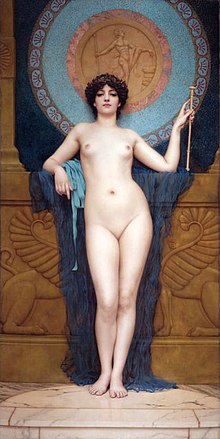Campaspe


Campaspe ( Greek Καμπάσπη ; also Pankaste ) was a Greek courtesan and mistress of Alexander the Great .
According to Pliny , Alexander is said to have brought his favorite concubine to the famous painter Apelles so that he could paint her naked. On this occasion Apelles fell in love with Kampaspe, whereupon Alexander magnanimously left his concubine to the painter he greatly admired. Kampaspe was also the model for the most famous picture of Apelles, Aphrodite Anadyomene rising from the sea .
The figure of the Kampaspe first appears in the Roman authors. It is not mentioned in the ancient biographies of Alexander. According to Claudius Aelianus , she came from Larissa in Thessaly and was the first woman with whom Alexander had sexual intercourse.
This episode of the triangle formed by the ruler, concubine and artist was picked up in both the fine arts and literature. Well-known designers of the subject were:
- Sebastiano Ricci
- Giovanni Battista Tiepolo (ca.1725)
- Angelika Kaufmann (Tondo, oil on copper, 1783, vorarlberg museum , Bregenz)
- Jérôme Martin Langlois (ca.1819)
- John William Godward (1896)
The English poet John Lyly wrote a comedy Campaspe (1584) and the Spanish poet Pedro Calderón de la Barca processed the subject in his play Darlo todo y no dar nada (1651). In German literature, the subject was dealt with by August Wilhelm Schlegel in a poem Kampaspe .
swell
- Pliny Naturalis historia 35.36
- Claudius Aelianus Varia historia 12.34
- Lukian from Samosata Panthea or The Pictures
Web links
- Kampaspe - poem by August Wilhelm Schlegel on Wikisource
| personal data | |
|---|---|
| SURNAME | Campaspe |
| ALTERNATIVE NAMES | Pancaste; Καμπάσπη |
| BRIEF DESCRIPTION | Greek hetaera |
| DATE OF BIRTH | 4th century BC Chr. |
| DATE OF DEATH | 4th century BC BC or 3rd century BC Chr. |